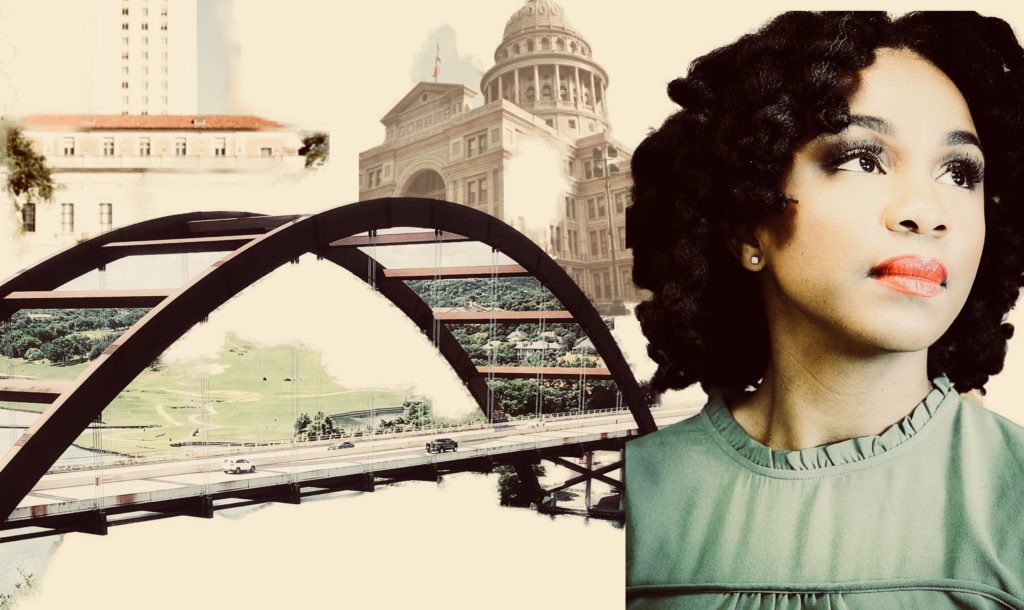The Black Bodies Project gives a voice to the black community in Austin.
By Kaiti Evans

Everyone sees the world through a unique lens, one that affects how we interpret the culture and people surrounding us. Multimedia journalist Charlotte Moore is on a mission to share her community’s lens with Austin.
Moore grew up in East Austin in the 1970s. After a stint in Denver, Moore decided to return to her beloved hometown. When she arrived, the gentrification of East Austin had already overtaken much of the area she once knew. Developers had moved in, property taxes were higher and Austin’s black community had decreased.
The black community currently makes up about 8.1 percent of the population of Austin, and while the population of the city continues to increase, the black population is stagnant if not shrinking. Faced with these statistics, Moore decided to create an avenue to highlight the black community: The Black Bodies Project.
“How do we get more black people here? That’s not the point,” Moore says. “The point is for the black people who are still here, [to]retain them.”
Bringing more awareness to the Austin community became her goal for the three-part project. She hoped a film, a book and an interview series would spark conversation among Austin and the world about what it really means to live in a black body. The project became more than she ever expected.
“There are a lot of people who have things to say and want to share their experiences and want to be a part of the city,” Moore says. “So, that’s what this project is about. It’s about awareness; it’s about helping show Austinites and Americans what it means to be black.”
Moore initially thought a 10-minute film would suffice but soon realized there was more to uncover. Hours were spent with black men and women of all ages as she listened to them talk about the reality of what it means to be black in Austin. After 16 separate interviews, her full-length documentary now gives a voice to their narrative.
“It is just these people talking about what it means to be black in Austin and in America,” Moore says. “There’s no anger; nobody’s mad; nobody’s lying and trying to keep us divided. It’s like they’re saying, ‘Listen to me and hear what I’m saying. Understand what it feels like for me when I walk into a room.’”
Moore chose a classic interview format for the film to fully depict the emotions of each interviewee.
“It is called Black Bodies because we live in these bodies daily,” Moore says. “So, I wanted to see the body and wanted you to see the skin, the eyes and the lips when they talk, even the freckles.”
As the film attracted more attention, it joined the film-festival circuit and has been screened in churches. Moore says the most beautiful part of the screenings are the conversations that follow. Viewers leave understanding each other’s existences in a deeper, richer way.
The book, however, is still in the making. Moore is collecting 200-word essays, paired with photos, reflecting the experience of being black. The essays poignantly address identity, racism and guilt. One woman wrote of her experience as a child when she was afraid of those with her same skin color.
“It’s the same thing that teaches white people to be afraid of black people that teaches us to be afraid of ourselves,” Moore says. “So, imagine the guilt and the sadness [this woman]felt. … She said she was uncomfortable and embarrassed that [she]was afraid of [her]own skin.”
The final element of the project is a YouTube channel called Brainstorm Black, which features a variety of interviews with Austinites from all racial backgrounds who are positively impacting the black community.
Many people have asked why Moore focuses on the black community. For her, the answer is simple: Racism persists in Austin.
“If you do the research, in every system in our city, [whether it be]education, health, academia or housing, black people are the most negatively impacted,” Moore says. “There’s no other reason other than racism, and by racism, we mean our system is set up such that black people…don’t have as much access.”
While slavery and legal segregation might be relics associated with an old Austin, racism thrives through microaggressions, statements, actions or incidents seen as subtle, indirect or unintentional discrimination against marginalized groups.
“If [white women walk]into any salon in Austin, those women in the salon will know exactly what to do with [their]hair, what makeup [they]wear,” Moore says. “They might be able to have makeup right there that matches [their]skin tone. If I walk into a salon in downtown Austin, chances are the women in there aren’t going to have any clue what to do with my hair. They may not have makeup that matches my skin tone. … As an Austinite, you have a choice of places you can go. My choices are limited.”
That is what it boils down to for Moore: awareness. She created The Black Bodies Project to offer the Austin community a much-needed change of perspective.
“I honestly feel like it’s a calling,” Moore says. “I feel like the universe asked me to do this. So…whatever stereotypes you have about black people in your city, do away with them because thisis who we are.”
Moore is the sole creator of The Black Bodies Project and is looking for sponsors to continue her work. She’s currently raising $10,000 to hire staff, publish the book and more. Visit her website to donate.


